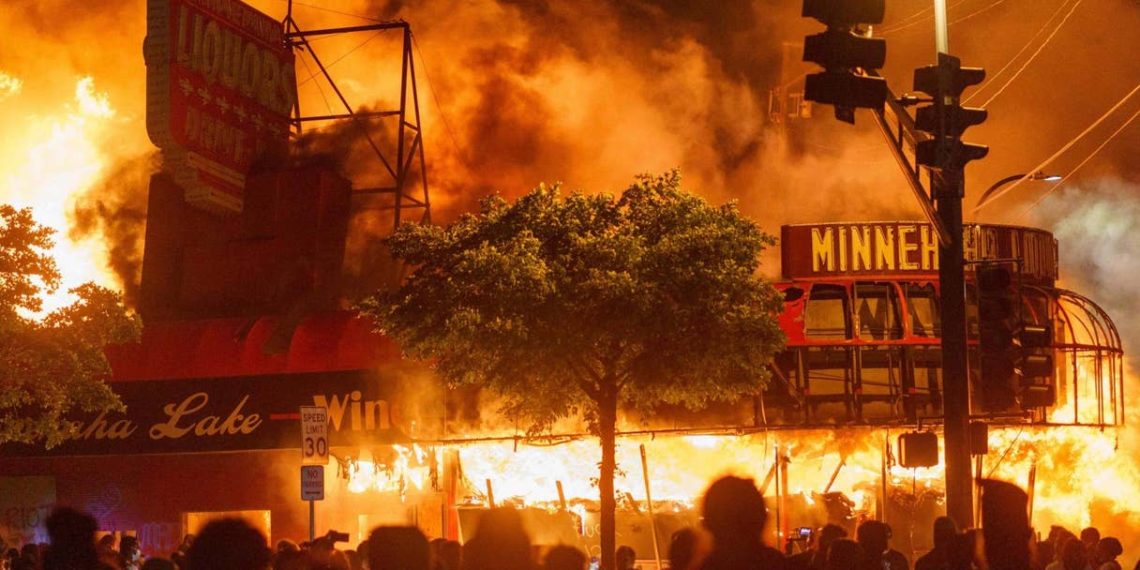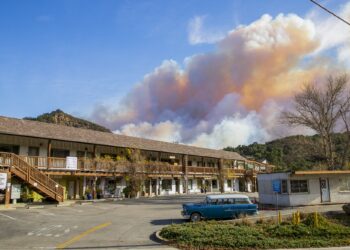I sit down to write in the wee hours of May 29, 2020. The city of Minneapolis is ablaze. Pandemonium broke out four or five hours ago, as thousands of angry mourning protesters surrounded the headquarters of the police 3rd Precinct. The protesters, some of whom engaged in vandalism and arson, demanded justice for George Floyd, a 46-year-old black man who was summarily murdered on Monday by Minneapolis policeman Derek Chauvin with the assistance of three other cops.
Chauvin is a French word that originally meant militaristic and later came to mean extremist nationalism. The cult to all things military, the militarization of police departments, the insatiable self-arming of millions of Americans, and white nationalism are cresting in this polarized and increasingly violent nation.
The Minneapolis 3rd Police Precinct on fire Thursday night. @StarTribune pic.twitter.com/sZncnG4tAz
— Carlos Gonzalez (@CarlosGphoto) May 29, 2020
Earlier this week, the COVID-19 pandemic reached a death toll of 100,000, a lugubrious milestone that had to compete for media attention with the death of a single black man named Floyd, who like many pandemic victims died because he could no longer breathe.
Around 1 am, protesters set the police precinct on fire. It might as well have been Nero’s Rome in 64 AD or the Bastille on July 14, 1789. There is also unrest and looting in the city’s smaller twin, named in honor of the martyred St. Paul, who was decapitated in the aftermath of the Great Fire of Rome. Nero did not play the violin – it would be invented in Italy fifteen centuries later – as the Eternal City burned; he blamed the disaster on the city’s Christian population.
Minneapolis and St. Paul, deemed among the most progressive cities in the United States, border the mighty Mississippi River. But what transpired on Monday, May 25 at the dawn of the third decade of the 21st century seems to come out of the annals of post-Civil War Mississippi or scenes from the film Mississippi Burning based on the 1964 execution of three black civil rights activists, James Chaney, Andrew Goodman, and Michael Schwerner by a murderous KKK band.
George Floyd’s Murder
On Tuesday, May 26, along with millions of viewers around the world, I watched the video of Floyd’s murder. Unfortunately, we have become used to seeing videos of white policemen killing unarmed black men but Floyd’s case is especially harrowing.
Floyd was a corpulent tall man capable of resisting anybody attempting to restrain him, yet he remained calm and compliant. His demeanor was that of a meek and friendly individual. He had earned the nickname of Gentle Giant.
Floyd’s torment lasted over seven minutes and was captured on video with audio. The most atrocious parts of the footage show a handcuffed Floyd, lying on the pavement while Chauvin pressed his knee onto Floyd’s neck. Another video from the opposite angle shows two other policemen crouched over his body.
And to think that this week had been hyped to be a milestone of American power and civilization with the scheduled launch of a manned rocket from Cape Canaveral. The launch had to be postponed because of thunderstorms.
Chauvin essentially sentenced Floyd to death by garrote, a method of execution by strangulation that suffocates its victims. The garrote is another gift from first-century Rome. Spanish conquistadors brought it to the Americas and used it to kill the Inca Atahualpa in 1533 and hundreds of other victims, among the last was Venezuelan-born filibusterer Narciso López, commander of an ill-starred expedition seeking to free Cuba from Spain.
‘I Can’t Breathe’
Equally horrific were Floyd’s final words. With an increasingly guttural voice, Floyd pleads repeatedly with his tormentor: “My neck hurts. Everything hurts”; “Water or something, please. I can’t breathe.”
The agonizing man demonstrates respect for his killer: please, please… Not one curse or angry word comes out of his lips which are taking on a whitish hue; he calls for his deceased mother as if knowing that he will soon meet her – or has already met her – on the other side. He goes silent and the video captures the moment of death.
Buildings continue to burn in the Twin Cities. The air is thick with smoke and hundreds of masked protestors chant Floyd’s final words: “Please, I can’t breathe .… Please, I can’t breathe…”
At around 2 am President Donald Trump tweeted impulsively, calling the protesters “THUGS,” deriding the boyish-looking mayor of Minneapolis as a radical leftist, and bowing to take control of the situation by force. “When the looting starts,” he tweeted ominously, “the shooting starts.” A couple of hours later, Twitter labeled the president’s tweet as “glorifying violence.”
….These THUGS are dishonoring the memory of George Floyd, and I won’t let that happen. Just spoke to Governor Tim Walz and told him that the Military is with him all the way. Any difficulty and we will assume control but, when the looting starts, the shooting starts. Thank you!
— Donald J. Trump (@realDonaldTrump) May 29, 2020
On the night before Floyd died, I had watched the last episode of the History Channel three-part documentary on another president, Ulysses S. Grant, and teared up at the scene of Confederate veterans massacring scores of blacks, freed only 10 years earlier, in Louisiana in 1873. The film highlighted the unfinished and failed character of post-Civil War Reconstruction.
A few hours later, or 147 years later, I found myself tearing up at the sight of Floyd’s public lynching. The nation is as polarized as it was during the time of Reconstruction and the parallels between the last 10 years and the Antebellum are glaring and foreboding.
The smell of civil war is in the air.
Disclaimer: The views and opinions expressed here are those of the author and do not necessarily reflect the editorial position of The Globe Post.





















